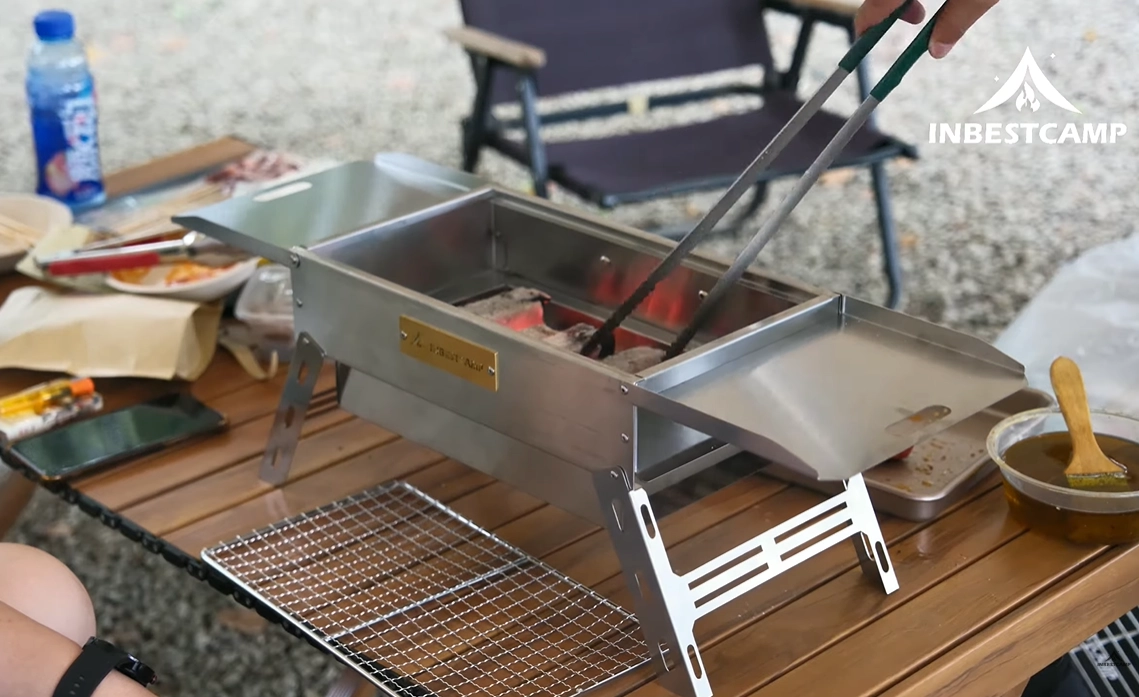Find out more about our news >
Comprehensive Structural Design Considerations for Building Wind-Resistant and Durable Outdoor BBQ Grills
Outdoor cooking is a beloved pastime for camping enthusiasts, backyard chefs, and adventure seekers alike. Yet, the challenge of maintaining a reliable, durable, and wind-resistant BBQ grill in unpredictable outdoor environments is often underestimated. At INBESTCAMP, we leverage 15 years of vertical manufacturing expertise to design and produce BBQ grills that withstand high winds, uneven terrain, and repeated outdoor use while offering a safe, high-performance cooking experience.
Real-World Challenges for Outdoor BBQ Grills
Outdoor conditions present unique challenges that influence grill performance. Gusty winds can disrupt flame stability, uneven ground can compromise structural integrity, and exposure to moisture and heat cycles can accelerate wear. Furthermore, outdoor grills often need to accommodate multiple users, varying fuel types, and transportation requirements. Traditional design approaches focusing solely on materials or aesthetics fail to address these holistic challenges.
Recognizing this, Tuoshenghe engineers approach grill design with a structural-first mindset, integrating wind resistance, heat management, portability, and durability into every product. This ensures that our grills are not only functional but also reliable under real-world outdoor conditions.
Integrated Structural Approach
One of the key principles in building a wind-resistant outdoor BBQ grill is integrating the structure rather than treating components separately. A well-designed grill is a unified system where the frame, cooking surface, and support legs work in synergy. This includes:
Reinforced frame geometry: Using cross-braced or triangulated supports to distribute weight evenly and resist tipping in gusts of wind.
Modular assembly: Components are engineered to interlock securely, reducing wobble while allowing easy disassembly for transport.
High-tensile joints: Key connection points undergo laser welding or robot-assisted seam welding, ensuring consistent strength without weak spots.
At Tuoshenghe, our intelligent manufacturing chain – from CNC pipe cutting to automated welding – ensures that every structural component meets strict tolerances, which is critical for durability in demanding outdoor conditions.
Wind-Flow and Heat Management
Wind can dramatically affect cooking efficiency and safety. A gusty environment may blow flames out or create uneven heating, while smoke can become a nuisance or hazard. Structural considerations to mitigate wind effects include:
Wind shields and airflow channels: Strategically positioned panels reduce flame disruption while optimizing oxygen flow for stable combustion.
Adjustable ventilation: Allows users to control airflow and maintain even heat, critical for grilling meat, vegetables, or pizza.
Heat retention surfaces: High-grade steel with thermal coating or anodized finishes reflects heat back onto the cooking surface, improving efficiency and reducing fuel consumption.
This integrated approach ensures that even in high winds or open terrains, Tuoshenghe grills deliver consistent, high-quality cooking results.

Load Distribution and Weight Optimization
Outdoor grills must balance stability with portability. Excessively heavy grills are difficult to transport, while lightweight designs can be prone to tipping. To resolve this, structural engineers focus on load distribution and weight optimization:
Base stability: Wide, reinforced legs with anti-slip foot pads provide a secure stance on sand, grass, or rocky terrain.
Even cooking surface support: Cross-braced grids support multiple pans or heavy cookware without bending or warping.
Weight-conscious materials: Stainless steel, high-strength aluminum, and lightweight composite panels maintain durability while keeping the grill portable for camping trips.
Tuoshenghe portable gas grills, for instance, weigh as little as 2 kg yet can sustain temperatures exceeding 200°C within minutes – an ideal balance of weight and performance for outdoor enthusiasts.
Multi-Functional Features for Outdoor Use
Modern outdoor BBQ grills must do more than just cook food. They need to integrate heating, storage, and safety features to enhance the outdoor experience:
Convertible cooking surfaces: Adjustable grates allow grilling, pan-frying, or using pizza stones.
Integrated side tables: Foldable surfaces provide prep space without adding permanent bulk.
Fuel versatility: Multi-fuel designs accommodate wood, charcoal, or gas, ensuring adaptability to various camping conditions.
Tool storage: Built-in hooks or compartments keep utensils, spices, and accessories within reach, reducing clutter and improving workflow.
Such thoughtful integration maximizes user convenience while ensuring a compact, transportable form factor.
Safety-First Design
Safety is paramount in outdoor grilling. Structural considerations can prevent accidents before they happen:
Anti-tip engineering: Wide stances and cross-bracing reduce the risk of tipping over.
Heat shielding: High-temperature-resistant panels protect users from accidental burns.
Fire containment: Sealed combustion chambers prevent sparks from escaping, protecting tents and dry foliage.
Splash-proof surfaces: Coated surfaces minimize grease flare-ups and facilitate safe cleaning.
By embedding safety into structural design rather than treating it as an afterthought, Tuoshenghe grills provide reliable protection for families and groups in any outdoor scenario.

Maintenance-Oriented Structural Considerations
Durable outdoor grills must be designed for easy maintenance and long life:
Removable grates and drip trays: Simplify cleaning and reduce the buildup of residue.
Rust-resistant coatings: Powder-coated steel and anodized aluminum surfaces withstand repeated exposure to moisture and heat.
Modular replacement parts: Individual components can be replaced without discarding the entire grill, extending overall lifespan.
Protective carrying cases: Durable Oxford cloth or custom cases protect grills during transport and storage.
These design decisions reduce downtime, improve hygiene, and ensure that grills continue performing at their best for years.
Customization & Brand Adaptability
For outdoor brands seeking to offer OEM or ODM grills, structural design flexibility is key:
Size adjustments: Catering to single campers or large groups.
Material options: Tailoring weight, heat retention, and corrosion resistance to specific customer requirements.
Color and branding: Powder coating and laser-etched logos for brand identity.
Modular add-ons: Side burners, storage racks, or wind shields can be incorporated based on user preference.
INBESTCAMP’s vertically integrated manufacturing and extensive patent portfolio allow brands to rapidly develop and deploy customized BBQ grills that meet precise functional and aesthetic specifications.
FAQ
Q1: How do wind-resistant grills perform in extreme conditions?
A1: Grills designed with reinforced frames, wind shields, and controlled airflow maintain stable flames and cooking temperatures even in gusts up to 60 km/h.
Q2: Can lightweight grills support heavy cooking equipment?
A2: Yes, with optimized load distribution and cross-bracing, lightweight grills can safely support pots, pans, and pizza stones without warping.
Q3: How do I clean and maintain a durable outdoor grill?
A3: Removable grates, drip trays, and anti-corrosion coatings simplify cleaning. Modular parts allow replacements instead of full unit disposal.
Q4: Are these grills suitable for OEM/ODM customization?
A4: Absolutely. Tuoshenghe offers flexible material, size, and accessory options to match brand specifications and design aesthetics.
Q5: Can multi-fuel grills switch between wood, charcoal, and gas?
A5: Yes. Multi-fuel systems are designed to accommodate fuel changes while maintaining consistent heat and safety standards.
Conclusion: Engineering Excellence for Outdoor Grilling
Creating a wind-resistant, durable outdoor BBQ grill requires a holistic engineering approach – integrating structural integrity, heat management, weight distribution, safety, maintenance, and brand customization. With 15 years of manufacturing expertise, Tuoshenghe delivers products that not only meet these engineering standards but also enhance the outdoor cooking experience for both casual campers and professional outdoor chefs.
By emphasizing structural design over individual components, engineers can ensure that outdoor BBQ grills remain reliable, safe, and enjoyable across varied environments – from backyard patios to high-altitude mountain campsites.




 RELATED MAGAZINE
RELATED MAGAZINE 











